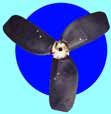

On the basis of over 2500 propeller years of service we have received a number of inquiries which we have documented generally involve a common theme of the engine overloading when reverse is engaged.
Assuming the Kiwiprop is well greased internally and all the blades are free to move about their mounting as when new then this can be caused by a number of possible issues.
GEARBOX REVERSE RATIO:
One cause of this can be that the reverse ratio of the gearbox is lower (leading to higher shaft rpm in reverse than ahead). This is an uncommon situation and is most likely to be found on Lombardini and some Westerbeke models. Sizing an optimum propeller for a reduction ratio of 2.6:1 in ahead will always lead to constraints on engine rpm in reverse when the reverse reduction ratio is say 2.18:1 simply due to the higher shaft speeds.
OEM GEARBOX:
Another issue - particularly with older engines is that they may no longer be fitted with the original gearbox supplied with the engine and may now have an OEM box of another brand or reduction ratio.
It is for this reason we always ask for the actual reduction ratio in both Ahead and Astern.
SPRING TENSION:
Another occasional problem we have seen particularly for Kiwiprops that have been re-assembled is that the internal torsion spring tension is too high causing reverse engagement 1/2 way through cycle leaving blades at — 45 deg of pitch. This will cause the engine to overload in reverse. In these situations the blades are in effect beginning to rotate and generating reverse thrust before they have adopted the full reverse position.
ENGINE POWER LOSS:
: We have also seen a number of situations where after much research as to why the engine was overloading in reverse (and to some lesser degree in Ahead) it was discovered that the engine had lost compression on one cylinder (always nearest the water injection bend) and that the marginal loss of power coupled with small increases in pitch (all Kiwiprops go to a maximum pitch position in reverse) was sufficient to create an overload situation in reverse.
ENGINE IDLE SPEEDS:
We have also seen situations where due to a low idle speed (which may be caused by auxiliary power take off e.g. compressor) the Kiwiprop unit was not able to engage fully before overloading the engine. This could be exacerbated by a cold engine and particularly applies to small engines at the lower end of the power range. It is not an issue engines > 30 hp. The operating manual has quite specific shaft idle rpm constraints - it is important to observe these as the Kiwiprop was tested within the operating environments of the most popular engine types. This is more relevant with higher reduction ratios such as 3:1.
GEARBOX OIL LEVELS:
Another issue we have seen on a number of occasions is low levels of oil in the gearbox. Modern gearboxes that are of a clutch type use oil pressure from the engine driven side of the gearbox to engage the gearbox. Yanmar Saildrives (SD20 - SD30’s) use a dog clutch and are not affected. Low oil levels can cause a slow engagement of the reverse ratio leading to the Kiwiprop unit adopting a 45 deg reverse position for the blades and loading up
Before flicking to the normal reverse position as would happen if the gearbox was engaging to specification.
UNIT LUBRICATION:
By far the most common cause of reverse overload is a lack of lubrication inside the Kiwiprop. This can be in the boss of the unit and or on the individual blades of the unit which must be free to move easily about their mounting pin at all times.
This assumes there is no binding caused by external fouling - e.g. Barnacles or antifouling.
While we would expect the Kiwiprop to operate without maintenance between haul outs - Kiwiprops in High use or in very dirty or abrasive operating environments such as encountered in shallow Sandy rivers or maneuvering within lock systems will require monitoring to ensure they are lubricated.
Kiwiprops in chalk or coral areas may also see high levels of deposits inside and around the unit.
It is important to ensure these deposits are monitored to ensure they don't effect the operation of the Kiwiprop which depends upon low levels of friction within all the moving parts.
Current Kiwiprops have O Rings in the blade roots and while not visible our tests have shown these will contribute to ensuring high levels of grease retention within the unit over time.
The Operating Manual supplied with the Kiwiprop and available off the web details lubrication requirements both for the individual blades and for the boss.
While in a perfect world the Kiwiprop would not require lubrication - in the real world the extremely harsh operating environment for all propellers requires they be regularly lubricated to maintain their functionality.